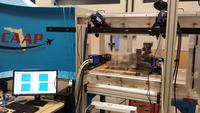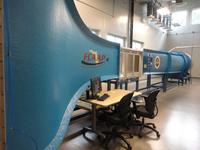Subsonic Wind Tunnel Facility
Subsonic Wind Tunnel Facility

The Florida Center for Advanced Aero-Propulsion (FCAAP) at the Florida State University is home to the low speed wind tunnel which allows for high-fidelity aerodynamic testing. The facility is a single pass, Eiffel styled, wind tunnel which is driven by a 200 hp suck-down fan, which minimizes noise through the test section. The facility incorporates a 30" wide x 30" high x 60" long test section and allows for testing at a range of speeds from 2 - 80 m/s (5 - 180 mph). The upstream flow conditioning devices allow for tests to be ran with minimal flow angularity and turbulence intensities less than 0.5%. The test section is easily reconfigurable, allowing it to be used for a wide variety of test requirements. The wind tunnel is equipped with a 3-axis motorized traverse for acquiring traditional 'probe-type' measurements including hot wire anemometry and pressure probes. The motorized traverse is also used as a camera and laser support, allowing for detailed flow field measurements using non-intrusive measurements such as Particle Image and Laser Doppler Velocimetry. The wind tunnel maximizes optical access of the test section allowing the development of cutting-edge optical diagnostics.
Operational/Test Capabilities

- Freestream velocity = 2 - 80 m/s (5 - 180 mph)
- Turbulence Intensity = <0.5%
- Run duration = Infinite
- Test Section Size: 30″ x 30″ x 60″
Diagnostics and Test Hardware

- LabVIEW based facility operation and data acquisition programs
- Planar (2D), Stereoscopic (3D), and Tomographic (3D) Particle Image Velocimetry
- Pulsed ND-YAG laser and High resolution CCD cameras
- High-speed Pulsed ND-YAG laser (10kHz)
- Hotwire Anemometry and Pitot-Static probes
- High frequency unsteady pressure sensors
- Signal conditioning systems including amplifiers, low and high pass filters
- High speed simultaneously sampling data acquisition cards
- Computer controlled 3-axis traverse system
- Skin friction and oil flow visualizations
- Smoke visualization
- Force measurements using 6-component strain gauge balances
Research and Development Activities

- Flow separation studies
- Control of flow over turbine blades
- Automotive bluff bodies in ground proximity
- Bio-inspired separation flow control using riblets
- Active control to eliminate/reduce flow separation using high momentum microjets
- Development of optimal control strategies
- Active-adaptive control strategies
- Transition flow control and optimal disturbance studies
- Vortex asymmetries on cones as high angles of attack
- Use of 'smart' materials for mitigation of streamwise vortices from 3D wing tips
Supervisor: Dr. Rajan Kumar, rkumar@eng.famu.fsu.edu

